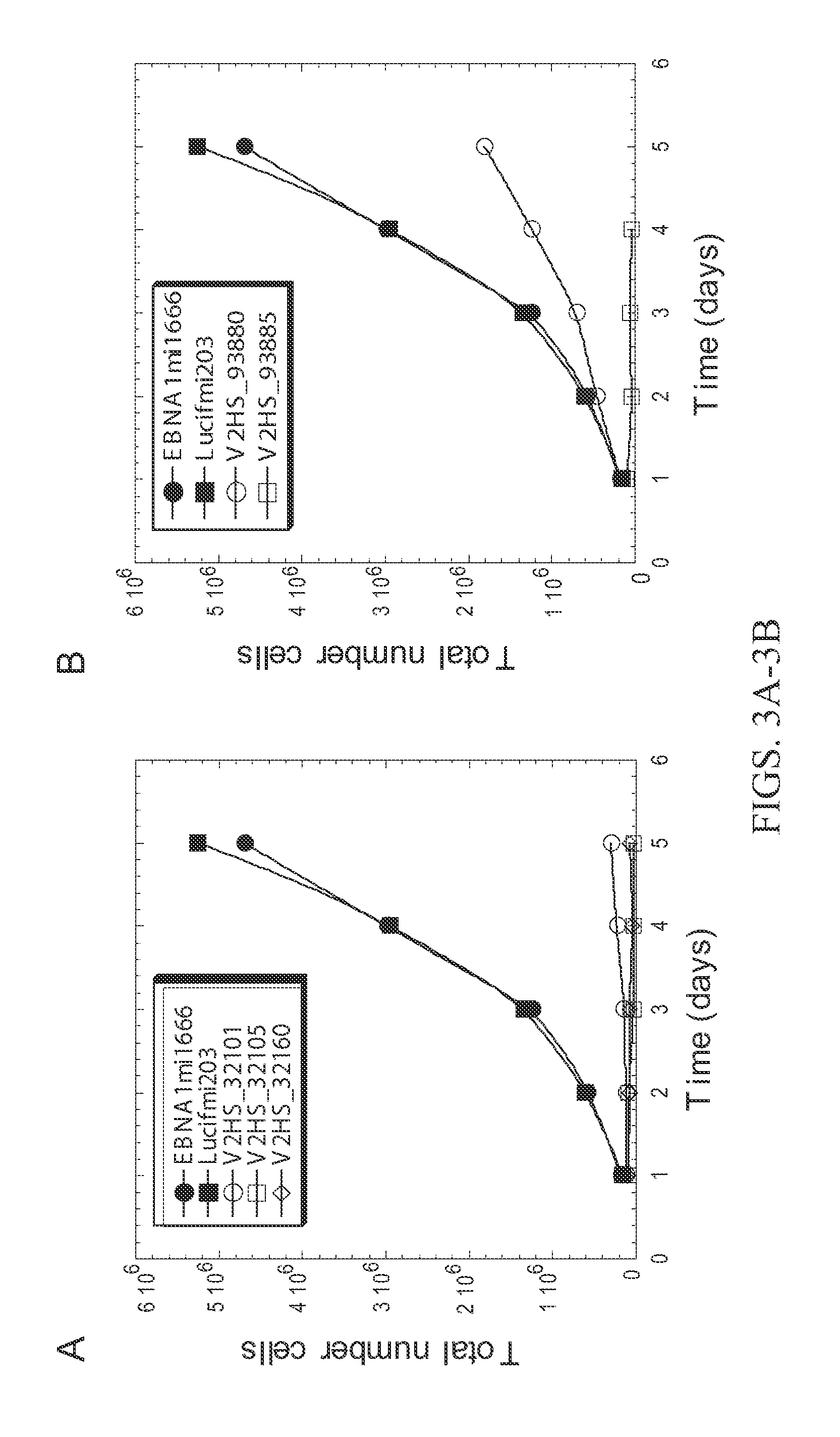Identification of rnai targets and use of rnai for rational therapy of chemotherapy-resistant leukemia and other cancers
a technology of rnai and target, which is applied in the direction of viruses/bacteriophages, drug compositions, anhydride/acid/halide active ingredients, etc., to facilitate pooled shrna negative selection screening
- Summary
- Abstract
- Description
- Claims
- Application Information
AI Technical Summary
Benefits of technology
Problems solved by technology
Method used
Image
Examples
example 1
5.1 Example 1
In Vitro Screening Assay for RNAi Target Identification
[0217]5.1.1 Construction of pLM-Puro Plasmid and Subcloning of shRNAs
[0218]The mir30-based shRNAs used in this invention are most effective in knocking down expression of their target gene if they are under the transcriptional control of a Pol II promoter. shRNAs, with the exception of EBNA1mi1666, Lucifmi203, ORC1mi550, ORC2mi1903, and ORC2mi1981, were purchased from Open Biosystems, which provided the shRNAs in the pSM2 plasmid, containing a Pol III promoter (U6 promoter). All shRNAs were sub-cloned from pSM2 to the pLM-puro plasmid, where shRNA expression is regulated by an upstream LTR element that functions as a Pol II promoter.
[0219]The pLM-puro plasmid was constructed as follows. The pMSCV plasmid (obtained from Clontech) was linearized with EcoRI (unique restriction site in the multiple cloning site of pMSCV) and the following short duplex was ligated into pMSCV:
(SEQ ID NO: 15)aattcgtaaaacgcgtacgacggcct(SEQ ...
example 2
5.2 Example 2
Cytotoxicity of shRNAs in Human Cancer Cells
[0233]The assay described in Example 1 was used to identify shRNAs against DNA replication proteins that had the greatest anti-proliferative effect on HCT116 cell cultures. FIG. 2 shows those hairpins with greater than two-fold inhibition of proliferation. shRNAs targeting RRM1, RPA1, RPA3, and PEST were effective. See FIG. 2 and FIG. 3. FIG. 4 shows a Western blot analysis of expression of RPA subunits in HCT116 cultures transformed with RNAi molecules against RPA3 and RPA1. RPA3 expression is abolished by two shRNAs targeting RPA3.
TABLE 1Cell numbers in experimental shRNA transduced culturesat 5 days post-infection (normalized to average of cellscounted in negative control shRNA transduced cultures)Cell # in culture / averagecell number in negativeGeneshRNA IDcontrol culturesRRM1V2HS_938850.06872852RPA1V2HS_321600.10996564RPA3V2HS_321050.16494845PES1V2HS_2540800.17721519PES1V2HS_1966730.27848101RPA3V2HS_321010.3161512PCNAV2HS_...
example 3
5.3 Example 3
Cytotoxicity of siRNAs in Human Cancer Cells
[0234]siRNAs derived from the shRNAs of Example 2 were all highly cytotoxic to HCT116 cells. The siRNA sequences and shRNAs from which they were derived are shown below
RPA3(SEQ ID NO: 8)RPA3si1417: CAUCUUAUGUCCAGUUUAA (v2HS_32101)(SEQ ID NO: 9)RPA3si1403: CACCAUCUUGUGUACAUCU (v2HS_32105)RRM1(SEQ ID NO: 10)RRM1si1820: CAGAUCUUUGAAACUAUUU (v2HS_93885)CDC45(SEQ ID NO: 11)CDC45si384: CAGUCAAUGUCGUCAAUGUAU (v2HS_172575)
[0235]The numbers refer to the location in the cDNA sequences for the respective genes that these sequences initiate. In parenthesis are the Codex and Open Biosystems catalog numbers for the shRNAs from which these siRNAs were derived.
[0236]Cytotoxicity was determined by the reduction in culture confluency over time after transfection of the siRNA relative to negative control RNAi cultures. Interestingly, in the shRNA context V2HS—32105 was more cytotoxic than V2HS—32101. However in the siRNA context the opposite was...
PUM
| Property | Measurement | Unit |
|---|---|---|
| Volume | aaaaa | aaaaa |
| Volume | aaaaa | aaaaa |
| Volume | aaaaa | aaaaa |
Abstract
Description
Claims
Application Information
 Login to View More
Login to View More - R&D
- Intellectual Property
- Life Sciences
- Materials
- Tech Scout
- Unparalleled Data Quality
- Higher Quality Content
- 60% Fewer Hallucinations
Browse by: Latest US Patents, China's latest patents, Technical Efficacy Thesaurus, Application Domain, Technology Topic, Popular Technical Reports.
© 2025 PatSnap. All rights reserved.Legal|Privacy policy|Modern Slavery Act Transparency Statement|Sitemap|About US| Contact US: help@patsnap.com



